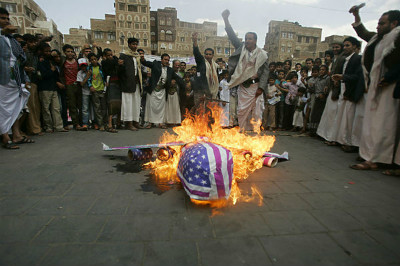By Jason Thomson
The Obama administration released a report Friday detailing the number of civilian deaths from US counterterrorism strikes in countries other than its three primary "areas of active hostilities," namely Iraq, Syria, and Afghanistan.
Most of these fatalities came about as a result of the controversial drones program, initiated under President George W. Bush but expanded under President Obama. The report was published the same day as an executive order that seeks to minimize civilian casualties going forward.
While the release of these statistics represents an important and long-awaited step toward transparency, some human rights groups say that the official figures hugely underestimate reality.

Protesters loyal to the Shi'ite al-Houthi rebel group burn an effigy of a US aircraft during a demonstration to protest against what they say is US interference in Yemen, including drone strikes, after their weekly Friday prayers in the Old Sanaa city, Yemen, on April 12, 2013. (Photo: Khaled Abdullah/Reuters)
“Today’s disclosure is a crucial shift away from the Obama administration’s longstanding policy of concealing information about civilians killed in drone strikes,” said Naureen Shah, Director of Amnesty International USA’s Security and Human Rights Program, in a statement. “It is a vital step in dismantling the dangerous precedent of a global, secret killing program.”
The report, published by the Director of National Intelligence (DNI), puts the number of “non-combatant” deaths at somewhere between 64 and 116, from January 20, 2009 to December 31, 2015. These numbers come from 473 strikes outside the "areas of active hostilities.”
Most took place in Yemen, Libya, Pakistan, and Somalia, although one of the biggest criticisms of the publication is its failure to provide context for the figures, such as specific incidents or even geographic location.
“While any disclosure of information about the government’s targeted-killing policies is welcome,” Jameel Jaffer, Deputy Legal Director of the American Civil Liberties Union, told the Bureau of Investigative Journalism (BIJ), “the government should be releasing information about every strike – the date of the strike, the location, the numbers of casualties, and the civilian or combatant status of those casualties.
“The public has a right to know who the government is killing – and if the government doesn’t know who it’s killing, the public should know that.”
The numbers themselves have also been criticized, as the BIJ estimates that drone strikes in these countries are responsible for between 380 and 801 civilian deaths.
But the BIJ also concedes that both its own statistics and the official numbers show a remarkable decline in civilian casualties in recent years: Pakistan, the country with the biggest number of strikes, has had only three reported civilian casualties since the end of 2012. Two of those were Western hostages held by Al Qaeda.
Moreover, the DNI report acknowledges the “differences between US Government assessments and reporting from non-governmental organizations,” highlighting the fact that information in government hands may be unavailable to others, while also outlining the different ways in which “non-combatant” may be defined.
Mr. Obama’s expansion of drone strikes in the “war on terror” has won many critics, whom this report is unlikely to mollify. The accompanying executive order, say analysts, which outlines “best practices” and directs the DNI to release annual statistics, is an attempt to lay a foundation of greater transparency and accountability for the next occupant of the White House.
“President Obama’s willingness to comprehensively assess the impact of [the] drone program and to apologize and compensate victims, will ultimately influence his human rights legacy and set a clear benchmark for the next administration and the one after that,” said Amnesty's Dr. Shah. “This is not the end of the public conversation on US drone strikes, but just the beginning.”



